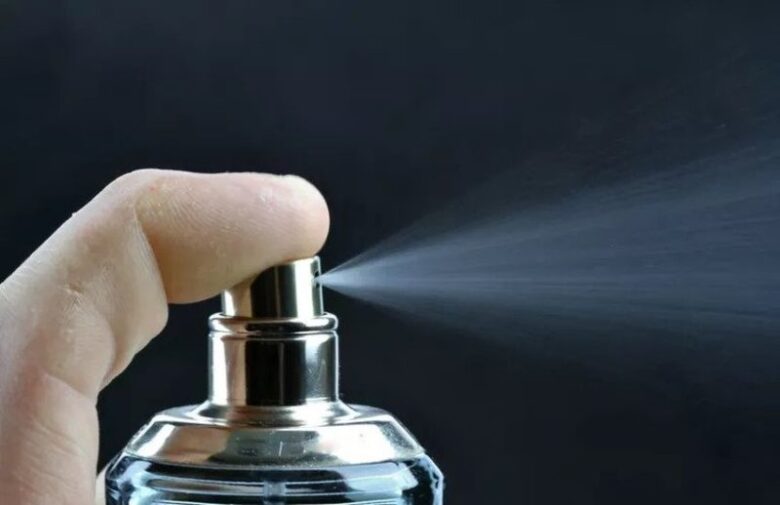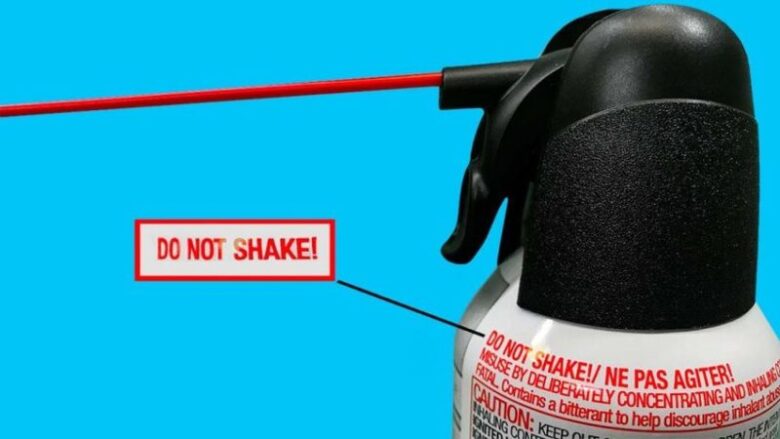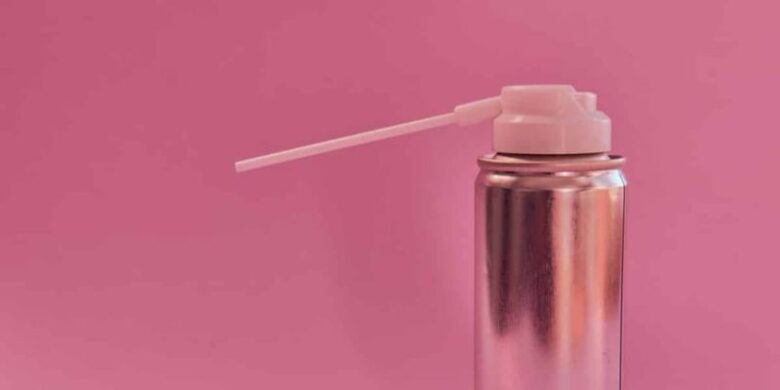We’ve all seen air dusters in the stores, particularly used for cleaning computer equipment. They’ve been around for years, but it’s time for a new alternative. So here, we’re going to take you through the pros and cons of using traditional air dusters,
But first, let’s start by understanding what an air duster actually is, then we’ll dive into more detail…
What is an Air Duster? Also known commonly as canned air, compressed air dusters, computer cleaner, gas duster, and other names. A canister of compressed air and gas is vented through a narrow nozzle, to create a high powered air spray device to force dust and other particles out of small, fragile and/or hard to reach places.
Now that we’re all clear on the type of product we’re talking about, let’s go on to talk about the benefits of Air dusters, then we’ll get on to the dangers, and finally talk about what better options are available.
Are Canned Air Dusters – Air?
As strange as it sounds, canned air dusters are not actually canned air, they’re traditionally called that, but in fact, they’re a mix of ingredients. Mostly considered refrigerant propellants. This is why canned air usually produces an icy blast when used.
In fact, as well as having a cold blast of air, canned dusters are harmful if you breathe in too much of the chemicals. Let’s look at what chemicals are in Air Dusters.
Unlike the cans of 20+ years ago, CFC’s are no longer present in aerosols, so the contents will not unduly affect the Ozone Layer. But they do contain chemicals, which is why you need to be 18 or older to purchase them.
Let’s take a look at what chemicals are contained in your average Canned Air Duster…
| Chemical (code) | Summary/Details |
| HFC-134a (CAS #811-97-2) | Nonflammable, industrial/electrical use, adds to global warming, hazardous |
| HFC-152a (CAS #75-37-6) | Flammable, Consumer retail, less effect on global warming, hazardous |
| HFO-1234ze (CAS#29118-24-9) | A recent new formula, nonflammable, some effect on global warming, hazardous |
| CO2 (CAS #124-38-9) | Uses Carbon Dioxide, small cartridges, erratic spray, hazardous |
| DME (CAS #115-10-6) | Highly flammable, rarely used, illegal in some places, hazardous |
We’ve included the chemical and their codes here, so you can check your current canned air, or even check your hair spray and other aerosols to see what they contain. Just take a look at the back of any can and it should tell you, then reference it against our table above.
Most of the air dust canisters you’ll find in retail will contain HFC-152a. This essentially contains either butane gas or propane gas. That’s right, the same types of gases you’ll find in your outdoor grill or your cigar lighter! Hence why these gases are marked as hazardous and/or bad for the environment.
The unfortunate truth is that these chemicals are used in the manufacturing process, not because they enhance the product, or because they’re safer, but simply because they’re cheap.
Health Risks of Canned Air
Not everyone is aware that you should not inhale the contents of an air canister. So many may do this without realizing when using the product.
This Practice is Known as “Huffing” or “Dusting”.
This practice is illegal, which is why any cans kept in your home should be monitored and where possible should be kept under lock and key. In moves to deter youngsters from taking up this activity, manufacturers have introduced “bitterants” into retail air canisters to make the air taste bad if inhaled.
The downside is the reduced effects of the product. Bitterants can create a residue on sprayed materials. This is certainly not what you want the spray for, but could also present a further hazard.
What is the liquid in Canned Air?

You may have experienced turning your Compressed air canister upside down, or even tilting it to far over and finding that what looks like water begins to spray out.
That liquid is not water! It’s difluoroethane, the gas, which is a refrigerant, that is in the dusting gas, which is compressed into a liquid form.
The liquid is compressed difluoroethane, the dusting “gas” that can be easily compressed into liquid form – and it is a refrigerant, not an accelerant. There are no chemical reactions (for which accelerants are used) going on here – just changes in the “state” of the matter (liquid to gas).
It won’t damage plastics or most other surfaces, but spraying liquid onto your surfaces and components isn’t the desired effect you wanted to achieve and as many of these consumer-based liquids are flammable you could be creating a needless fire risk.
One thing to note here is that the reason the liquid works is that a small amount of liquid can create a lot of gas when turned into gas form. So if the liquid starts to spray out, that’s a lot of canned “air” that is being used up.
Why is Canned Air Becoming Unpopular

With the ongoing effects of climate change and a world that is now struggling to make up for the damage of previous generations of climate misuse …and in more recent times, the effects of continued landfill – and single-use products. There is a definite movement toward creating better, more environmental solutions to what was seemingly ok before.
With that in mind, it’s time for a change, and while still gradual, it was only a matter of time before compressed single-use gas canisters came under increased scrutiny.
What seemed fine to use right up till a year ago, is now deemed a terrible way to solve a problem. It’s time to throw away your canisters!
But there are still going to be those times when we need to clean or clear dust from something! So What alternatives are there for using compressed gas canisters? Let’s take a look.
Alternative to Compressed Gas Duster Canisters
Aside from using a small low-level duster such as a bulb duster to manually pump air – as used by many photographers, there is only one solution to emerge as a much cleaner, safer and consistent way of cleaning your dust away.
There’s a solution available which means no one will berate you for damaging the environment and has countless benefits over traditional compressed dusters. Canless Air is now the very best product you can use. Let’s talk about the benefits of the Canless Air product.
Canless gas products like the best selling Hurricane is rechargeable in a standard house socket the same as your other appliances. It’s being adopted throughout industries, education, and healthcare, as well as thousands of homeowners. The list of tasks that a careless air can be used for is endless.
Here’s a list of the benefits over canned gas
Hurricane Canless System…

- Is cleaner than using compressed gases because it just uses the same air that you breathe
- You can use it over and over again, its not single-use, so it can be charged again and again and last for years
- Will last much longer than a compressed duster on a single charge, in fact, up to nearly 30 times longer than a gas canister according to tests.
- Can be used in tight spaces that won’t mean you’re inhaling noxious fumes
- Reduces landfill
- Released less gas into the environment
- Reduced plastics and metal use
- Less carbon footprint for manufacture and distribution
We encourage you to stop using environmentally unfriendly products, switch today and be cleaner in so many ways! Find out more about the benefits of the Hurricane Canless Air System at canlessair.com.


